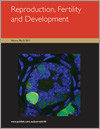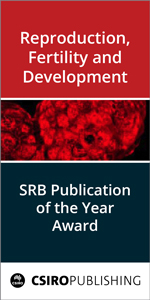Reproduction, Fertility and Development
Volume 29
Number 12 2017
Is the temperature in a preovulatory follicle lower than in adjacent tissues? Using a novel non-invasive approach it was demonstrated that bovine follicular fluid before ovulation is cooler than the uterine surface and deep rectal tissues, whereas temperature is not reduced in follicles suffering ovulation failure. Follicular antral temperature could become a more valuable indicator of oocyte potential than a purely morphological assessment.
The reproductive effects of melatonin have been extensively studied, but its involvement in the local control of ovarian physiology has not yet been clarified. The present research, which was undertaken to study the effects of physiological levels of melatonin on the main parameters of swine granulosa cell function, documents that the hormone is involved in the modulation of ovarian follicle growth and development.
In PCOS, elevated levels of plasma androgens affects the quality of oocytes and ovulation rate, and causes anovulation in women of reproductive age. We studied the mechanism in a mouse model of PCOS, and showed that intracytoplasmic oxidative stress in oocyte via increase in histone acetylation and decrease in DNA methylation and histone dimethylation alters epigenetic modification. Consistently, mRNA expression of DNA methyltransferase-1 and histone deacetylase-1 was decreased with PCOS. There was a significant correlation between ROS production and increased histone acetylation. We concluded that antioxidant therapy in PCOS is a viable approach to reduce the adverse effects of epigenetic alterations.
In cattle, a major limitation of the success of IVF is the developmental competence that oocytes acquire during ovarian stimulation. The aim of the present study was to better understand the follicular conditions associated higher versus lower embryo yields. We revealed that the level of follicular differentiation (timing) is the main cause of failure and provide new biomarkers to identify such follicular conditions to adapt the ovarian stimulation protocol to individual animals.
Andrographolide should be prudently consumed by women attempting to conceive. The aim of the present study was to investigate the effects of andrographolide on oocytes. The findings indicate that andrographolide may disrupt mouse oocyte meiotic maturation and fertilisation potential by blocking cytoskeletal reorganisation. This study provides an important platform for understanding the potential adverse effects of andrographolide on female fertility.
Deficiencies in the initiation of embryo elongation play a major role in early embryonic mortality in the pig. This study demonstrates that embryos encapsulated and cultured in alginate hydrogels with the integrin-binding Arg-Gly-Asp (RGD) sequence had increased embryonic survival and modulation of gene expression to support increased steroid production and adequate immune responsiveness, with a larger number exhibiting the morphological changes compared to other in vitro treatments in this study. These results illustrate the importance of the integrin-binding RGD peptide sequence for stimulating the initiation of embryo elongation and improving embryo survival.
Porcine embryos contain substantial amounts of lipid, with little known regarding its metabolic role during development. This study investigated the association of lipid metabolism with carbohydrate substrates in the culture medium and revealed positive effects of adding L-carnitine, a limiting co-factor required for lipolysis, on early cleavage and blastocyst quality. Supplementing medium with L-carnitine is a useful strategy to improve the success of porcine blastocyst vitrification.
The notable pathophysiological event that occurs in testicular torsion–detorsion (T/D) is ischaemia–reperfusion (I/R), which lacks efficient clinical treatment. Herein we describe, for the first time, the protective effects of polydatin, a traditional Chinese medicine, against testicular T/D injury in the rat. Our findings may provide new clues for male infertility associated with testicular torsion.
Binding of spermatozoa to the egg coat is a key step in fertilisation and provides a mechanism for reproductive isolation and sexual selection. To test this theory we investigated the molecular evolution of the ZP3 gene and its encoded sperm-binding region in a diverse murine rodent group. Our analyses provides evidence for positive selection on the sperm-binding region in several murine lineages, but the nature of the selective force remains unresolved.
The importance of the oviduct for different reproductive processes is known; however, the molecular mechanisms underlying oviductal regulation are not fully understood. The results of the present study demonstrate that gene expression in the oviduct is regulated during the oestrous cycle, with some oviductal proteins that could be related to several reproductive processes being described for the first time. These findings are very important in our understanding of the different processes that take place in the oviduct as fertilisation or early embryo development.
Enzymatic disaggregation of murine ovaries yielded higher numbers of morphologically intact follicules than previously reported. The molecular markers DAPI, CMXRos and alpha-tubulin were applied to assess post-harvest follicular morphology, mitochondrial function and cellular cytoskeleton respectively. A new preparation of animal origin-free collagenase IV caused more damage to follicular integrity, mitochondrial function and the cytoskeleton than enzyme-free mechanical isolation, but another preparation of collagenase IV ovarian disaggregation gave the highest yield of morphologically intact follicles containing viable mitochondria.
Bull semen quality traits are vital parameters in evaluating the fertility potential of bulls. In the present study we demonstrated that a single nucleotide polymorphism within the exonic splicing enhancer motif caused aberrant splicing of the RAB, member of RAS oncogene family like 2B (RABL2B) gene, and that semen quality differed among Chinese Holstein bulls with different RABL2B genotypes. These results also provide a novel research idea for further elucidating the complex molecular mechanism underlying the regulation of bull fertility.
Although oocyte cryopreservation is desired for the preservation of female germplasm, the developmental competence of vitrified porcine oocytes has been notoriously low due to unclear reasons. We investigated the effects of vitrification of porcine oocytes at the immature stage. Vitrification triggered premature nuclear resumption and nucleolar fragmentation from which some oocytes could recover, suggesting that enhancement of recovery processes might be a possible way to improve competency.
Subsequent infertility and testicular cancer are major problems for boys with undescended testis. This study aims to examine whether mouse has similar postnatal hormonal changes as boys, so it can be used as a model to study human testis development. Our results demonstrated that mouse can be used as a model for human minipuberty.
The expression of IL-11 is stimulated by LH/hCG in theca cells of preovulatory follicles via PKA-MAPK pathway and TLR4 activation. IL-11 increases progesterone production by stimulating StAR expression.
The selection of fertile males is important to augment fertility in cows, and breeding soundness examinations may not provide information on the fertility potential of bulls. Expression levels of seminal plasma RNAs may be used to predict the fertilising ability and cryotolerance of bull semen. Such non-invasive tests using seminal plasma may aid in the assessment of the health of the reproductive tract and in the selection of males for breeding.
Seminal plasma bathes the sperm upon ejaculation but its function has yet to be fully defined. This study sought to characterise the effect of seminal plasma from bulls of high or low fertility on sperm function. Seminal plasma reduced osmotic resistance of epididymal sperm, regardless of whether it was from high or low fertility bulls.
The factors initiating puberty have not been clearly revealed. The present study compared serum total and high molecular weight (HMW) adiponectin levels between girls with central precocious puberty (CPP) and age-matched controls. Total adiponectin levels were low, but HMW adiponectin levels were high in girls with CPP, which probably leads to decreased inhibition of gonadotrophin-releasing hormone neuronal activity. This may provide an insight into how adipokines are involved in the initiation of puberty.
Resistin and visfatin, two adipokines, modulate reproduction in the gonads, but their actions at the hypothalamic–pituitary level are not known. We showed in vitro that these hormones decreased LH secretion from mouse gonadotroph cells and that in vivo visfatin may be a myokine as well as an adipokine in mice. Our findings suggest that these hormones may influence mouse female fertility by regulating LH secretion at the pituitary level.
The developing fetal brain is a potent target for endocrine chemical disruption by bisphenol A (BPA) because of its lipophilicity. In the present study, perinatal exposure to BPA changed the expression of genes regulating the hypothalamic–pituitary–testis (HPT) axis at the hypothalamic, pituitary and testes levels. Maternal exposure to BPA during fetal differentiation of the sexually dimorphic nucleus of the hypothalamus caused reprogramming of the HPT axis in adult male offspring




